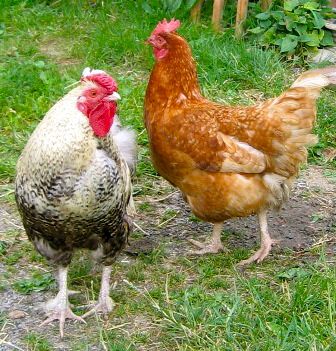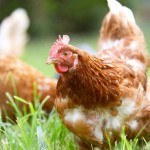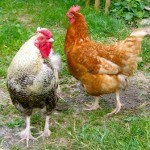Pet Advice Guides for Pet Owners, Sanctuary Life
Chickens for beginners
Chickens make delightful pets with the added advantage that they’ll lay you an egg for your tea. Whilst you have to learn how to look after them, there is nothing too difficult about their care. You can either study the different breeds and select a certain type – large, small, fluffy, speckled – Brahmas, Bantams, Frizzles, Marans – or buy whatever mixed breed hens are available in your locality. The colour of the eggs is determined by breeding, so if you would like white eggs go for Light Sussex. Deep brown eggs from the Marans, blue eggs from Auracanas and eggs in every shade in between from the hybrids. The most common hens are Warrens, these are the ones shown in the pic. They are a cross between Rhode Island Reds and Light Sussex. This is man made selection and intended to provide a heavy table bird and a good egg layer. This is the breed most likely to be kept intensively in miserable conditions. Warrens are easy to find at markets where they are sent when their laying days are over. They will usually have lost their feathers and won’t have a clue about outdoor living. These are young birds though and soon pick up. A hen kept in intensive conditions won’t last much longer than a year – she’ll live many more years with you when she has access to fresh air and freedom.
This hen has recovered and is coming in to lay. You can tell this by the colour of her comb which is nicely pink. When she is in full lay her comb will be red. The cockerel has no impact on the hen’s ability to lay eggs, she will produce them whether there is a cockerel around or not. If you just keep hens the eggs will not be fertile though and you won’t see any chicks, whether she sits on them or not. If a cockerel is kept with the hens the eggs will be fertile and any that they sit will hatch out, if you are lucky that is. They don’t always hatch if the conditions are not right (more about that in another article).
Whether you rescue or buy pure breds the first consideration is that they are healthy. This isn’t the same as them being in poor condition. A thin hen without many feathers will pick up when she gets better nutrition and fresh air. A poorly hen will need veterinary treatment and possibly spread disease. Don’t buy any poultry that look as though they are gasping for breath or croaking or keeping their beaks open. If they have sticky eyes that aren’t fully open, they are in trouble and should be avoided. Don’t handle any birds that look ill. If you have done so inadvertently, wash hands thoroughly, change your clothes and disinfect your shoes. Poultry diseases are very contagious.
Healthy birds have bright eyes and feathers and they look alert. Check their legs and feet – if there are clumps of grey rough patches on their legs they will be suffering from scaly leg. You can treat this fairly easily with a bought in spray but you will have to keep the bird in quarantine first or the mite will spread to your hen hut and other birds might become infected. Watch out for lameness in any of the hens you are thinking of purchasing – quite a lot of hens have deformed feet, this is because they have been intensively bred or are from stock that is interbred. They won’t do well if they are limping and in pain. It’s worth having a good feel round the feet – any lumps or swellings are caused by bumble foot. This is caused when the perches are not the right shape and the hen’s foot becomes sore and a swelling forms. Again this can be cured, but do you want to be poulticing and bandaging the feet of your new arrival. If you are rescuing the bird, that is a great kindness to make her comfortable again, if you’re buying her, think again.
(next time – housing and keeping your birds safe)



